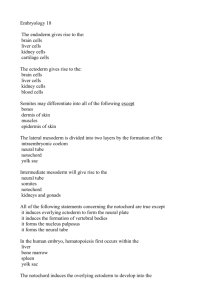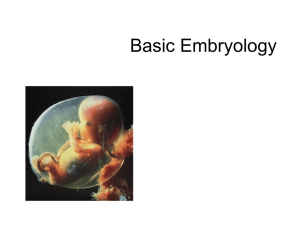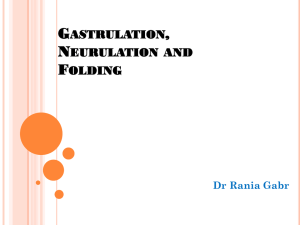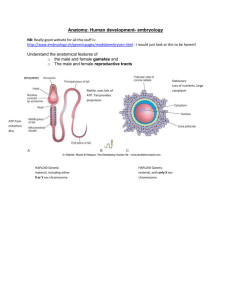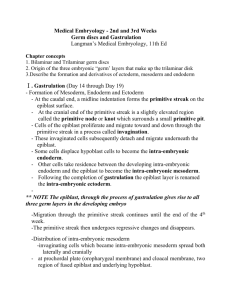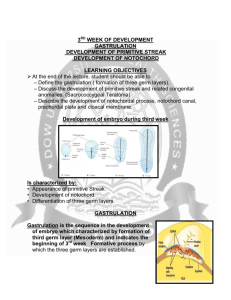4_Trilaminar_Embyo_(week3)
advertisement
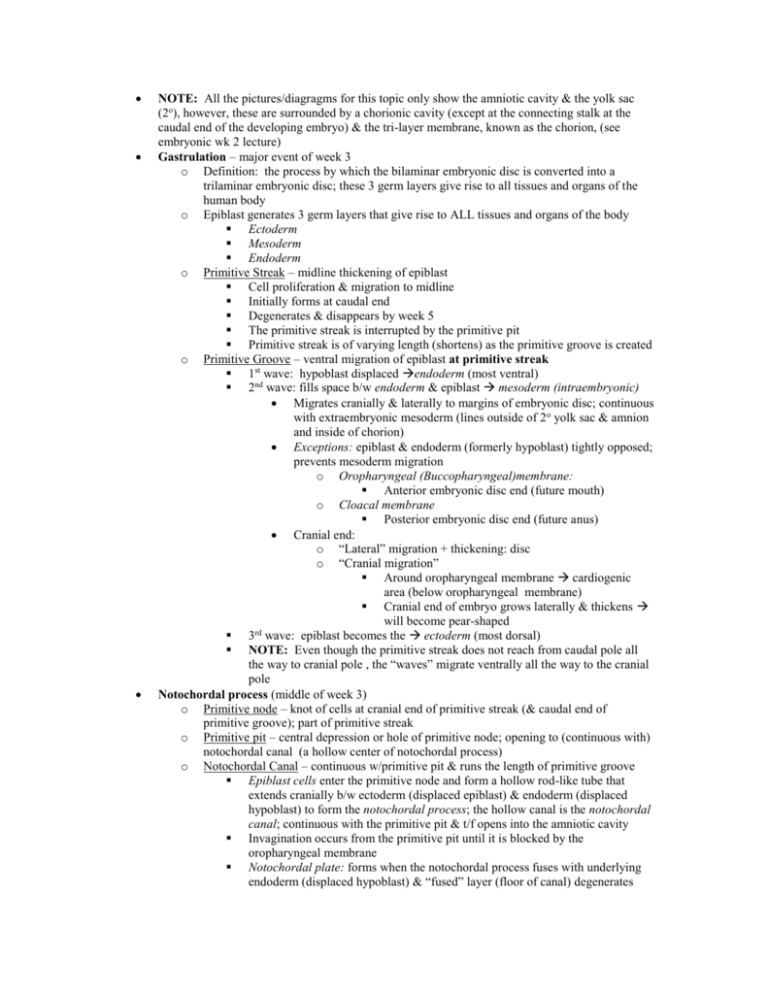
NOTE: All the pictures/diagragms for this topic only show the amniotic cavity & the yolk sac (2o), however, these are surrounded by a chorionic cavity (except at the connecting stalk at the caudal end of the developing embryo) & the tri-layer membrane, known as the chorion, (see embryonic wk 2 lecture) Gastrulation – major event of week 3 o Definition: the process by which the bilaminar embryonic disc is converted into a trilaminar embryonic disc; these 3 germ layers give rise to all tissues and organs of the human body o Epiblast generates 3 germ layers that give rise to ALL tissues and organs of the body Ectoderm Mesoderm Endoderm o Primitive Streak – midline thickening of epiblast Cell proliferation & migration to midline Initially forms at caudal end Degenerates & disappears by week 5 The primitive streak is interrupted by the primitive pit Primitive streak is of varying length (shortens) as the primitive groove is created o Primitive Groove – ventral migration of epiblast at primitive streak 1st wave: hypoblast displaced endoderm (most ventral) 2nd wave: fills space b/w endoderm & epiblast mesoderm (intraembryonic) Migrates cranially & laterally to margins of embryonic disc; continuous with extraembryonic mesoderm (lines outside of 2 o yolk sac & amnion and inside of chorion) Exceptions: epiblast & endoderm (formerly hypoblast) tightly opposed; prevents mesoderm migration o Oropharyngeal (Buccopharyngeal)membrane: Anterior embryonic disc end (future mouth) o Cloacal membrane Posterior embryonic disc end (future anus) Cranial end: o “Lateral” migration + thickening: disc o “Cranial migration” Around oropharyngeal membrane cardiogenic area (below oropharyngeal membrane) Cranial end of embryo grows laterally & thickens will become pear-shaped 3rd wave: epiblast becomes the ectoderm (most dorsal) NOTE: Even though the primitive streak does not reach from caudal pole all the way to cranial pole , the “waves” migrate ventrally all the way to the cranial pole Notochordal process (middle of week 3) o Primitive node – knot of cells at cranial end of primitive streak (& caudal end of primitive groove); part of primitive streak o Primitive pit – central depression or hole of primitive node; opening to (continuous with) notochordal canal (a hollow center of notochordal process) o Notochordal Canal – continuous w/primitive pit & runs the length of primitive groove Epiblast cells enter the primitive node and form a hollow rod-like tube that extends cranially b/w ectoderm (displaced epiblast) & endoderm (displaced hypoblast) to form the notochordal process; the hollow canal is the notochordal canal; continuous with the primitive pit & t/f opens into the amniotic cavity Invagination occurs from the primitive pit until it is blocked by the oropharyngeal membrane Notochordal plate: forms when the notochordal process fuses with underlying endoderm (displaced hypoblast) & “fused” layer (floor of canal) degenerates opening the notochordal canal to the yolk sac below—like exocytosis with a tube instead of a vesicle “Newly” formed opening & primitive pit becomes the neurenteric canal; serves communication b/w amniotic & yolk sac fluids Remains until end of wk 3 & becomes “flattened” notochordal plate o Definitive notochord (completed in week 3) From the cranial end (opposite direction of notochord generation), notochordal plate rounds up into a solid core (like endocytosis with a tube instead of a vesicle) Endoderm grows back together, closing off neurenteric canal Definitive notochord separates from endoderm to form a solid rod-shaped structure known as the definitive notochord o Notochord Function: defines primordial axis of the embryo; provides rigidity Important inducing & organizing structure: Induces overlying ectoderm to form neural plate (important for spinal cord development) Vertebral column forms around notochord (which is anterior to future spinal cord) Neurulation (weeks 3 – 4): formation of neural tube which generates the CNS o New terminology: Neuroectoderm: intraembryonic ectoderm (former epiblast) dorsal to notochord/mesoderm (from 2nd wave of epiblast cell migration) Paraxial mesoderm: intraembryonic mesoderm (from 2nd wave of epiblast migration) adjacent to notochord o Neural Plate & Neural Tube: Neural Plate: thickening of neuroectoderm along midline; induced by developing notochord and paraxial mesoderm Neural Plate Folding: Day 18 Neural plate invaginates along midline; forms neural grove with neural folds on each side of groove Neural Tube: end of week 3 Neural folds fuse & form neural tube Closure begins in the middle of the neural tube (“midway b/w prechordal & cloacal membranes”) & progresses both caudally & cranially As neural tube closes, the attached edges of surface ectoderm (former epiblast) are pulled to the midline where they fuse and become continuous overylying (or dorsal to) the neural tube Cranial & caudal neuropore closure completed at end of week 4 Forms future CNS o Neural Crest Specialized neuroectoderm (differentiated ectoderm) cells, at point of neural tube closure, differentiate creating an irregular mass of cells b/w the newly formed neural tube and the ectoderm (former epiblast) which is dorsal to neural tube This is an example of epithelial to mesenchymal phenotype transformation Cells migrate ventrolaterally from each side of neural tube; final migration point is lateral to the neural tube Generate PNS & variety of tissues throughout the embryo Cranial neural crest o Cranial nerve ganglia: V, VII, IX, X o CT around eye o Head mesenchyme o Dermal bones of skull o Dermis in the neck o Conotruncal septum of heart Spinal neural crest: o Dorsal root ganglia o Chain ganglia o Adrenal medulla Also: o Pia matter and arachnoid of the brain o Melanocytes o Schwann cells Mesoderm Segmentation & Somites o From notochord (medial to lateral): Paraxial Proliferates to generate the somites (cuboidal bodies); form in pairs on either side of neural plate & notochord 1st three (day 20) form in future occipital region; more form in craniocaudal sequence; 44 somites form by end of week 5 Somites form dermis (dermatome), musculature (myotome), & axial skeleton (sclerotome) Intermediate Lateral Contiguous with the extraembryonic mesoderm (surrounding the amnion & yolk sac) Horseshoe-shaped; surrounds embryo at margins – everywhere except in the caudal region (due to connecting stalk) Coalescence of lateral mesoderm spaces form a cavity (intraembryonic coelom); divides lateral mesoderm into dorsal (amnion side) & ventral layer (yolk sac side) o Dorsal: Somatopleure (somato = body; pleure = side) Somatic mesoderm + ectoderm Somatic mesoderm eventually surrounds body o Ventral: Splanchnopleure (splanchno = visceral; pleure = side) Splanchnic mesoderm + endoderm Splanchnic mesoderm eventually surrounds viscera (organs) Cardiovascular System o Heart is 1st functional organ; Circulatory system is operational by beginning of week 4 o Vasculogenesis Blood Vessels form in mesoderm from mesenchymal cells that become angioblasts Angioblasts aggregate to form blood islands Blood island cavities (contain lining of primitive endothelium) fuse into endothelial channels Surrounding mesoderm forms smooth muscle & CT of blood vessels Embryonic Vaculature: Umbilical Arteries – carry deoxygenated blood from the fetus to the placenta Umbilical veins – carry oxygenated blood from the placenta to fetus Primitive blood cells: Made by endothelial cells in yolk sac & allantois (yolk sac diverticulum into connecting stalk) Blood formation begins in embryo – week 5 o Cardiogenesis Cardiogenic Area (see Gastrulation/primitive groove section) Two endocardial heart tubes, formed from within the splanchnic (ventral) mesoderm (lateral) on either side of the embryo, fuse into a single heart tube (begins beating on day 22); See Folding Lecture for more details Sinus Venosus (? – mentioned briefly in lecture) Dorsal Aorta (? – mentioned briefly in lecture) Early Placenta – further development of chorionic villi o 3o Villi (= blood vessels present) appear late in week 3 o Branching villi are surrounded by intervillous space, which contains maternal blood Cardiovascular development correlates w/the appearance of blood vessels in the villi at the beginning of week 4 Capilliaries in the villi fuse to form arteriocapillary networks o Stem Villi: where branching villi connect to chorion; they contain large blood vessels o Anchoring Villi: where brancing villi contact the decidua – cytotrophoblast cells form proliferating columns o Cytotrophoblast (line inside of villi) cells extend through the syncytiotrophoblast layer (outer layer of villi) & populate the surface of the endometrium to form a cytotrophoblastic shell (separates endometrium & intervillous space; spiral arteries later supply blood to the intervillous space) o See Placentation Lecture for more details
